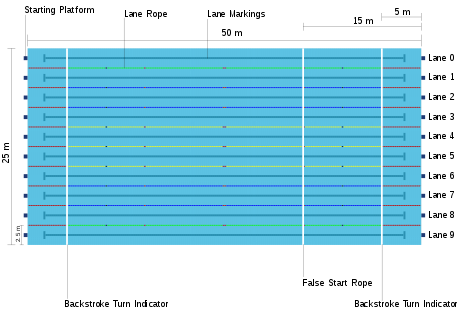


AnOlympic-size swimming pool conforms to regulated dimensions that are big enough for international competition. This type of swimming pool is used in the Olympic Games, where the race course is 50 metres (164.0 ft) in length, typically referred to as "long course", distinguishing it from "short course" which applies to competitions in pools that are 25 metres (82.0 ft) in length, or 75 feet (22.9 m) in the United States. If touch panels are used in competition, then the distance between touch panels should be either 25 or 50 metres to qualify for FINA recognition. This means that Olympic pools are generally oversized, to accommodate touch panels used in competition.
An Olympic-size swimming pool is used as a colloquial unitofvolume, to make approximate comparisons to similarly sized objects or volumes. It is not a specific definition, as there is no official limit on the depth of an Olympic pool. The value has an order of magnitude of 1 megaliter (ML).[1]
World Aquatics specifications for an Olympic-size pool are as follows:
| Physical property | Specified value |
|---|---|
| Length | 50 m (164 ft 1 in)[2] |
| Width | 25 m (82 ft 0 in)[2] |
| Depth | 2 m (6 ft 7 in) minimum, 3 m (9 ft 10 in) recommended.[2] |
| Number of lanes | 10 |
| Lane width | 2.5 m (8 ft 2 in) |
| Water temperature | 25–28 °C (77–82 °F) |
| Light intensity | minimum 1500 lux (140 footcandles) |
| Volume | 2,500,000 L (2,500 m3; 88,000 cu ft), assuming a nominal depth of 2 m. About 2 acre-feet. |
There must be two spaces 2.5 m (8 ft 2 in) wide outside lanes 1 and 8 (in effect, two empty lanes).[2] The length of 50 metres (164 ft) must be between the touch pads at the end of each lane, if they are used.[2] If starting blocks are used, then there must be a minimum depth of 1.35 metres (4.4 ft) from between 1 metre (3 ft) from the end of the pool to at least 6 metres (20 ft) from the end of the pool. At all other points, the minimum depth is 1 metre (3 ft).[2] If the pool is used for Olympic Games or World Championships, then the minimum depth is increased to 2 metres (7 ft).[2]

At FINA's 2009 Congress, rules were approved for 10-lane courses for competition, as an alternative to the more traditional 8-lane course.
This version of the Olympic-sized swimming pool debuted in the 2008 Beijing Summer Olympics. Beforehand, the Summer Olympics featured the more traditional 8-lane course with a depth of roughly seven feet,[3] now the minimum depth requirement. Twenty-five world records were broken at this pool.
The new Olympic-sized swimming pool was designed to provide advantages to competitors. Increasing the lane count from eight to ten introduces a "buffer lane", helping to absorb waves generated by movements of the swimmers.[3] The increased depth of the pool assists the lane lines in dissipating water churn, thereby creating less hydrodynamic drag.[3]